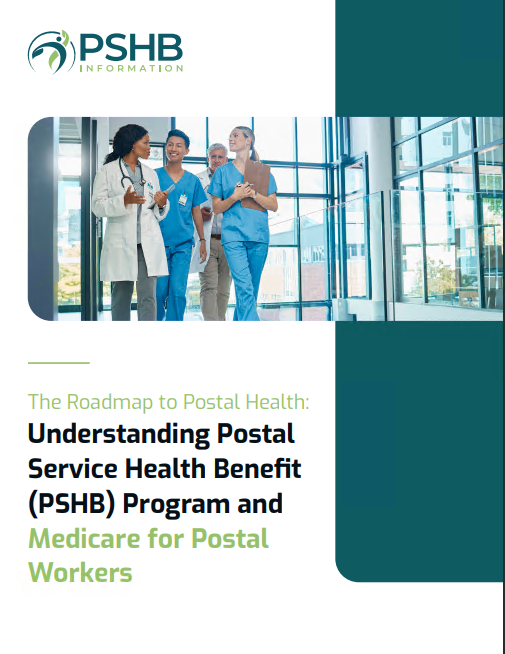Key Takeaways
-
If you are a Postal Service retiree or family member eligible for Medicare, enrolling in Part B is often required to maintain full PSHB benefits starting in 2025.
-
Not understanding how Medicare and PSHB work together could result in higher costs, reduced benefits, or even losing your PSHB drug coverage.
Understanding the New Medicare-PSHB Integration
Beginning in 2025, the Postal Service Health Benefits (PSHB) Program replaces FEHB for USPS employees and retirees. This shift introduces a unique dynamic with Medicare, especially for those aged 65 or older—or turning 65 soon. While PSHB plans may resemble traditional FEHB options, their integration with Medicare is significantly more structured.
If you’re eligible for Medicare Part A and Part B, you are now expected to enroll in both to maintain full PSHB coverage. This rule applies to Postal retirees and family members unless they qualify for specific exemptions. Missing this connection could lead to unwanted gaps in care or out-of-pocket costs that catch you off guard.
Who Needs to Enroll in Medicare?
You must enroll in Medicare Part B if:
-
You are a Postal Service annuitant or family member who is Medicare-eligible.
-
You were not retired or didn’t reach age 64 before January 1, 2025.
-
You reside in the United States and don’t have an exemption (such as VA or Indian Health Services coverage).
If you fall into one of the exempt categories—such as living abroad or already retired before 2025—you aren’t required to enroll in Part B but should still evaluate whether it benefits you.
What Happens If You Skip Medicare Part B?
Here’s where things become costly. If you’re required to have Part B and fail to enroll:
-
You may lose access to PSHB prescription drug coverage, which is provided through a Medicare Part D Employer Group Waiver Plan (EGWP).
-
Some PSHB medical plans will not cover major benefits (such as hospital or outpatient services) unless you’re enrolled in both Parts A and B.
-
You could be stuck with late enrollment penalties from Medicare that last for life.
In 2025, PSHB and Medicare are designed to function together. Skipping Medicare Part B weakens the coverage you’d otherwise receive.
How Enrollment Timing Affects You
Your timing determines not only your access to benefits but also how much you may pay. Here are the key periods:
-
Initial Enrollment Period (IEP): 7 months around your 65th birthday (3 months before, the month of, and 3 months after).
-
General Enrollment Period (GEP): January 1 – March 31 each year. Coverage begins July 1. Late penalties may apply.
-
Special Enrollment Period (SEP): For those who delayed Medicare because they had active employer coverage. This ends 8 months after employment or coverage ends.
For Postal retirees impacted by the new PSHB rules, a one-time Special Enrollment Period ran from April to September 2024. If you didn’t use that window and still aren’t enrolled in Part B, you may now have to wait until the GEP—possibly incurring penalties.
Coordination Between PSHB and Medicare in 2025
Your PSHB plan in 2025 is not designed to stand alone if you are Medicare-eligible. Instead, it assumes Medicare is your primary insurance and steps in as secondary. This coordination affects:
-
Provider billing: Medicare pays first, PSHB covers remaining eligible costs.
-
Cost sharing: Many PSHB plans waive or reduce copayments, deductibles, and coinsurance if you have Medicare Part B.
-
Drug coverage: Only Medicare-eligible members with Part B enrolled will receive automatic enrollment in the PSHB prescription drug plan.
That means without Medicare, you’re often left paying full cost for services your PSHB plan assumes Medicare already paid for.
Prescription Drug Coverage Is Tied to Medicare Enrollment
In 2025, PSHB offers prescription drug coverage through an Employer Group Waiver Plan (EGWP) under Medicare Part D. This plan includes:
-
A $2,000 annual out-of-pocket cap.
-
Lower copayments for common medications.
-
An expanded pharmacy network.
However, you must be enrolled in Medicare Part B to receive this drug coverage. If you opt out of Part B or Part D, your PSHB plan will exclude prescription drugs entirely. Even worse, once you opt out, you cannot re-enroll in the PSHB drug plan later.
Exemptions to the Medicare Requirement
Not everyone has to enroll in Medicare Part B to maintain PSHB benefits. You’re exempt if:
-
You retired on or before January 1, 2025.
-
You were age 64 or older as of January 1, 2025.
-
You reside outside the U.S.
-
You receive healthcare through Veterans Affairs (VA) or Indian Health Services (IHS).
Even if exempt, enrolling in Medicare Part B could still save you money on cost-sharing, reduce your out-of-pocket burden, and expand your provider access.
Financial Impact of Delaying or Avoiding Enrollment
Avoiding or delaying Medicare Part B isn’t just a matter of forfeiting benefits—it can trigger permanent financial penalties. In 2025, the Part B premium is $185 per month. If you delay enrollment beyond your eligible period:
-
You face a 10% penalty per 12-month period of delay.
-
This penalty is added for life to your monthly premium.
Additionally, missing out on reduced deductibles, waived coinsurance, or capped drug costs could lead to spending thousands more annually in healthcare expenses.
How Medicare Enrollment Improves PSHB Value
If you’re properly enrolled in Medicare, your PSHB plan becomes significantly more generous:
-
Lower or no deductibles for many services.
-
Waived or reduced copays for hospital and outpatient visits.
-
Integrated pharmacy benefits that reduce prescription costs.
-
Access to nationwide providers without worrying about out-of-network penalties.
By coordinating both systems, you effectively strengthen your health coverage without doubling your cost.
What You Should Do Next
If you haven’t already confirmed your Medicare status and reviewed your PSHB plan, now is the time. Follow these steps:
-
Verify your Medicare eligibility and enrollment status.
-
Determine whether you are exempt from the Part B requirement.
-
Review your PSHB plan brochure for Medicare coordination details.
-
Contact a licensed agent listed on this website if you need help assessing your options.
Annual Open Season runs from November to December, and it’s your window to adjust your PSHB coverage if needed.
Smart Coverage Decisions Require Clear Information
Understanding how Medicare integrates with PSHB isn’t just a detail—it’s the foundation of your retirement healthcare. The rules in 2025 mean that Medicare is no longer optional if you want your full PSHB benefits. What you decide now will shape the quality, cost, and availability of your healthcare moving forward.
The smartest move you can make? Learn the rules, act within the timelines, and talk to a licensed agent listed on this website for personalized, professional guidance before Open Season arrives.






